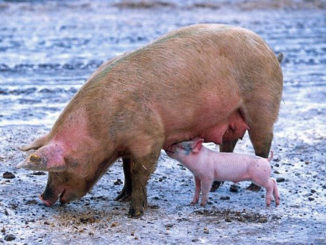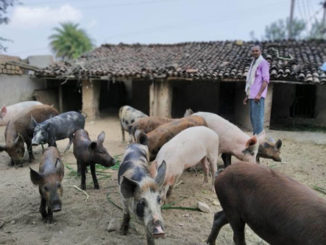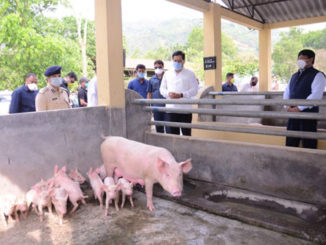Diagnosis of nutritional deficiency diseases is difficult by observation. Clinical symptoms are often product of a combination factors like malnutrition, poor managemental practices and infectious disorders, such as parasitism. The symptoms of most nutritional deficiencies are non-specific, such as a lack of appetite, stunted growth, and thriftiness. A single nutrient deficiency can cause inanition, and subsequent malnutrition can lead to multiple deficiencies. There is a possibility of a dietary deficiency without any obvious symptoms. In the field, the deficiency may be only slight or borderline, which makes diagnosis difficult.
For long-term deficiencies, Diagnosis of a deficiency by observing the response to nutritional therapy is not always clear. Only after observing all of the predicted clinical signs and a thorough evaluation of the animal’s dietary, illness, and management background should a nutritional deficiency be identified positively.
Protein Deficiency
Protein deficiency in growing and finishing pigs causes decreased gains, low feed conversion, and fatter carcasses due to suboptimal feed intake or a deficiency of one or more important amino acids. Milk production is reduced in lactating sows, excess weight loss occurs, and sows may fail to exhibit post weaning estrus or have delayed return to estrus. All essential amino acids must be liberated at rates commensurate with needs during digestion for optimum protein utilization. Therefore, protein supplements should not be handfed at irregular intervals, but should be combined with grain or made available as a free-choice option all times.
There has been no available evidence to support the hypothesis of pig “protein poisoning.” Diet rich in proteins (35–50%) were found to be laxative and less efficient in their use, but no harmful effects were observed.
Fat Deficiency
Certain long-chain polyunsaturated fatty acids are essential for swine. Linoleic acid is needed in the diet and is used to make longer-chain fatty acids, which are likely to be required as well. Hair loss, scaly dermatitis, skin necrosis on the neck and shoulders, and an unthrifty appearance are all symptoms of linoleic acid deficiency in growing pigs. Conventional swine diets usually contain adequate fat from natural sources to provide sufficient quantities of essential fatty acids.
Mineral Deficiency
Rickets in developing pigs and osteomalacia in mature pigs are caused by calcium or phosphorus deficiencies. Signs include deformity and bending of long bones, lameness in young pigs, fractures and posterior paralysis (a result of fractures in the lumbar region) in older pigs. If dietary calcium or phosphorus is deficient, sows that produce large amounts of milk and nurse large litters are more prone to posterior paralysis at the end of lactation or after weaning. These symptoms may also be caused by a vitamin D deficiency, but phosphorus deficiency is the most common cause.
Pigs fed low-salt (NaCl) diets grow poorly and inefficiently, owing to a significant reduction in feed intake. Bad hair and skin condition may grow as well, but this is not specific to salt deficiency. Salt-deficient pigs have been observed attempting to drink urine from other pigs.
Hairless, frail, and stillborn pigs are produced by sows fed iodine-deficient diets. The newborn pigs with a borderline deficiency may be poor only when they are born, but their thyroids are swollen and have histologic abnormalities. If iodine is not included in the diet, some feedstuffs (such as soybeans and soybean meal) contain goitrogens that can cause marginal goiter. Iodized salt at recommended levels prevents this deficiency.
Deficiencies of iron and copper reduce the rate of Hgb formation and produce typical nutritional anemia. Low Hgb and RBC levels, pale mucous membranes, enlarged heart, skin edema around the neck and shoulders, listlessness, and spastic breathing (thumps) are all signs of nutritional anemia in suckling pigs. Iron deficiency is more common than copper deficiency in nursing pigs that do not receive an iron injection or oral iron supplementation early in life.
A deficiency of zinc results in parakeratosis in growing pigs, particularly when fed diets high in phytic acid (or phytate, the primary form of phosphorus in cereal grains and oilseed meals) and more than the recommended amount of calcium. The exact mode of action of zinc in the prevention of parakeratosis is not known.
Selenium and/or vitamin E deficiency may result in the death of young, rapidly growing pigs. In addition, a deficiency in selenium/vitamin E renders nursing pigs more vulnerable to iron toxicosis from iron injections.
Vitamin Deficiency
Vitamin premixes are readily available for farm-mixed feeds, and most commercial diets are fortified with vitamins, so deficiencies are less common than they were years ago. Vitamin-A deficiency causes problems with the skin, as well as the epithelial tissues of the respiratory, reproductive, nervous, urinary, and digestive systems. Sows with impaired reproduction can produce blind, eyeless, frail, or malformed pigs. In pregnant sows, herniation of the spinal cord in fetal pigs has been identified as an unique sign of vitamin A deficiency. Growing Pigs deficient in vitamin A develop incoordination, night blindness, and respiratory problems. Vitamin A deficiency is uncommon due to the liver’s ability to store this vitamin.
Rickets, stiffness, weak and bent bones, and posterior paralysis are all symptoms of vitamin-D deficiency. These signs are difficult to differentiate from those caused by a calcium or phosphorus deficiency.
Vitamin-E deficiency can lead to problems with reproduction as well as a weakened immune system. Many of the signs of vitamin E deficiency are similar to those of selenium deficiency.
Pigs with a vitamin-K deficiency have a prolonged blood clotting time and are more likely to die from hemorrhages. Certain components in moldy feed can interfere with vitamin K synthesis. Also, excessive dietary calcium often inhibits vitamin K production, resulting in these symptoms.
Reproduction is impaired in pigs deficient in riboflavin; post pubertal gilts fail to cycle but show no other clinical symptoms. Deficient sows become anorectic and farrow dead pigs 4–16 days prematurely. The stillborn pigs have very little hair, often are partially resorbed, and may have enlarged forelegs. Growing pigs fed low-riboflavin diet gain weight slowly, have a poor appetite, a rough coat, a skin exudate, and can develop cataracts.
Pigs with a niacin deficiency have inflammatory lesions of the digestive tract, diarrhoea, weight loss, rough skin and coat, and ear dermatitis. Niacin deficiency or bacterial infection may cause intestinal problems. Pigs that are deficient in niacin respond well to treatment, and although it is not a cure for infectious enteritis, adequate dietary niacin helps the pig maintain its resistance to bacterial invasion.
When pigs and pregnant sows are fed pantothenic acid-deficient diets, they develop a typical “goose-stepping” gait, ataxia, and noninfectious bloody diarrhoea. Anorexia occurs when the deficiency becomes severe.
Choline deficiency causes incoordination and abnormal shoulder conformation in pigs. They may have fatty livers and show kidney damage at necropsy. Choline-deficient sows have smaller litters and are more likely to give birth to spraddle-legged pigs.
Excessive hair loss, skin ulcerations and dermatitis, exudates around the eyes, inflammation of the mouth’s mucous membranes, transverse cracking of the hooves, and cracking or bleeding of the footpads are all symptoms of biotin deficiency.
Neonatal pigs fed synthetic diets low in vitamin-B12 show hyperirritability, voice failure, pain and incoordination in the hindquarters. Histologic examination of the bone marrow reveals an impaired hematopoietic system. Fatty livers are also noted at necropsy.






Be the first to comment